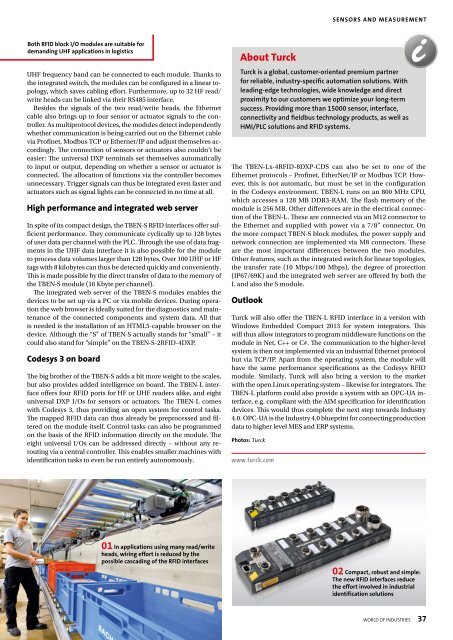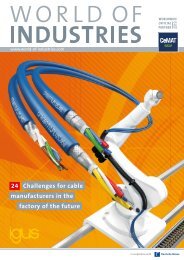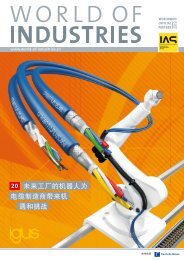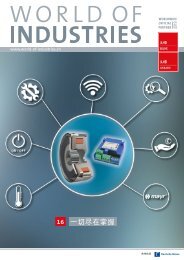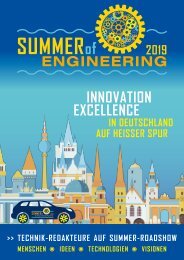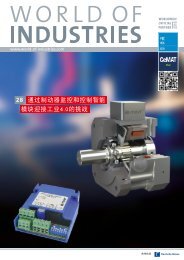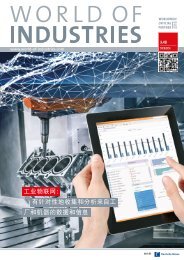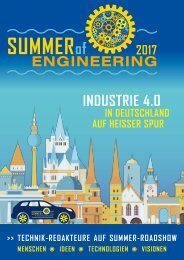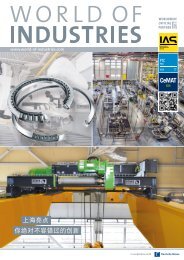world of industries 3/2017 (EN)
world of industries 3/2017 (EN)
world of industries 3/2017 (EN)
- TAGS
- world
- industries
You also want an ePaper? Increase the reach of your titles
YUMPU automatically turns print PDFs into web optimized ePapers that Google loves.
S<strong>EN</strong>SORS AND MEASUREM<strong>EN</strong>T<br />
Both RFID block I/O modules are suitable for<br />
demanding UHF applications in logistics<br />
UHF frequency band can be connected to each module. Thanks to<br />
the integrated switch, the modules can be configured in a linear topology,<br />
which saves cabling effort. Furthermore, up to 32 HF read/<br />
write heads can be linked via their RS485 interface.<br />
Besides the signals <strong>of</strong> the two read/write heads, the Ethernet<br />
cable also brings up to four sensor or actuator signals to the controller.<br />
As multiprotocol devices, the modules detect independently<br />
whether communication is being carried out on the Ethernet cable<br />
via Pr<strong>of</strong>inet, Modbus TCP or Ethernet/IP and adjust themselves accordingly.<br />
The connection <strong>of</strong> sensors or actuators also couldn’t be<br />
easier: The universal DXP terminals set themselves automatically<br />
to input or output, depending on whether a sensor or actuator is<br />
connected. The allocation <strong>of</strong> functions via the controller becomes<br />
unnecessary. Trigger signals can thus be integrated even faster and<br />
actuators such as signal lights can be connected in no time at all.<br />
High performance and integrated web server<br />
In spite <strong>of</strong> its compact design, the TB<strong>EN</strong>-S RFID interfaces <strong>of</strong>fer sufficient<br />
performance. They communicate cyclically up to 128 bytes<br />
<strong>of</strong> user data per channel with the PLC. Through the use <strong>of</strong> data fragments<br />
in the UHF data interface it is also possible for the module<br />
to process data volumes larger than 128 bytes. Over 100 UHF or HF<br />
tags with 8 kilobytes can thus be detected quickly and conveniently.<br />
This is made possible by the direct transfer <strong>of</strong> data to the memory <strong>of</strong><br />
the TB<strong>EN</strong>-S module (16 Kbyte per channel).<br />
The integrated web server <strong>of</strong> the TB<strong>EN</strong>-S modules enables the<br />
devices to be set up via a PC or via mobile devices. During operation<br />
the web browser is ideally suited for the diagnostics and maintenance<br />
<strong>of</strong> the connected components and system data. All that<br />
is needed is the installation <strong>of</strong> an HTML5-capable browser on the<br />
device. Although the “S” <strong>of</strong> TB<strong>EN</strong>-S actually stands for “small” – it<br />
could also stand for “simple” on the TB<strong>EN</strong>-S-2RFID-4DXP.<br />
Codesys 3 on board<br />
The big brother <strong>of</strong> the TB<strong>EN</strong>-S adds a bit more weight to the scales,<br />
but also provides added intelligence on board. The TB<strong>EN</strong>-L interface<br />
<strong>of</strong>fers four RFID ports for HF or UHF readers alike, and eight<br />
universal DXP I/Os for sensors or actuators. The TB<strong>EN</strong>-L comes<br />
with Codesys 3, thus providing an open system for control tasks.<br />
The mapped RFID data can thus already be preprocessed and filtered<br />
on the module itself. Control tasks can also be programmed<br />
on the basis <strong>of</strong> the RFID information directly on the module. The<br />
eight universal I/Os can be addressed directly – without any rerouting<br />
via a central controller. This enables smaller machines with<br />
identification tasks to even be run entirely autonomously.<br />
About Turck<br />
Turck is a global, customer-oriented premium partner<br />
for reliable, industry-specific automation solutions. With<br />
leading-edge technologies, wide knowledge and direct<br />
proximity to our customers we optimize your long-term<br />
success. Providing more than 15000 sensor, interface,<br />
connectivity and fieldbus technology products, as well as<br />
HMI/PLC solutions and RFID systems.<br />
The TB<strong>EN</strong>-Lx-4RFID-8DXP-CDS can also be set to one <strong>of</strong> the<br />
Ethernet protocols – Pr<strong>of</strong>inet, EtherNet/IP or Modbus TCP. However,<br />
this is not automatic, but must be set in the configuration<br />
in the Codesys environment. TB<strong>EN</strong>-L runs on an 800 MHz CPU,<br />
which accesses a 128 MB DDR3-RAM. The flash memory <strong>of</strong> the<br />
module is 256 MB. Other differences are in the electrical connection<br />
<strong>of</strong> the TB<strong>EN</strong>-L. These are connected via an M12 connector to<br />
the Ethernet and supplied with power via a 7/8” connector. On<br />
the more compact TB<strong>EN</strong>-S block modules, the power supply and<br />
network connection are implemented via M8 connectors. These<br />
are the most important differences between the two modules.<br />
Other features, such as the integrated switch for linear topologies,<br />
the transfer rate (10 Mbps/100 Mbps), the degree <strong>of</strong> protection<br />
(IP67/69K) and the integrated web server are <strong>of</strong>fered by both the<br />
L and also the S module.<br />
Outlook<br />
Turck will also <strong>of</strong>fer the TB<strong>EN</strong>-L RFID interface in a version with<br />
Windows Embedded Compact 2013 for system integrators. This<br />
will thus allow integrators to program middleware functions on the<br />
module in Net, C++ or C#. The communication to the higher-level<br />
system is then not implemented via an industrial Ethernet protocol<br />
but via TCP/IP. Apart from the operating system, the module will<br />
have the same performance specifications as the Codesys RFID<br />
module. Similarly, Turck will also bring a version to the market<br />
with the open Linux operating system – likewise for integrators. The<br />
TB<strong>EN</strong>-L platform could also provide a system with an OPC-UA interface,<br />
e.g. compliant with the AIM specification for identification<br />
devices. This would thus complete the next step towards Industry<br />
4.0. OPC-UA is the Industry 4.0 blueprint for connecting production<br />
data to higher level MES and ERP systems.<br />
Photos: Turck<br />
www.turck.com<br />
01 In applications using many read/write<br />
heads, wiring effort is reduced by the<br />
possible cascading <strong>of</strong> the RFID interfaces<br />
02 Compact, robust and simple:<br />
The new RFID interfaces reduce<br />
the effort involved in industrial<br />
identification solutions<br />
WORLD OF INDUSTRIES 37


